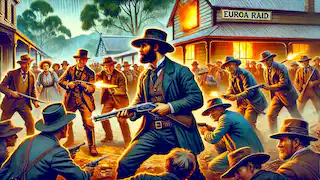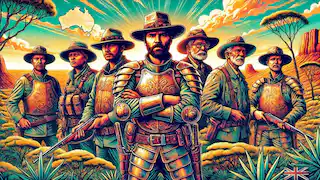Introduction
Ned Kelly, one of Australia's most notorious outlaws, was born in 1854 to Irish immigrant parents. His early life was marked by hardship and brushes with the law, setting the stage for his transformation into a folk hero. The Kelly Gang, consisting of Ned, his brother Dan, and their associates Joe Byrne and Steve Hart, emerged during a period of intense social and political unrest in colonial Australia. The gang's story is a tale of defiance, resilience, and the quest for justice against perceived tyranny.
Ned Kelly's father, John "Red" Kelly, was a convict transported from Ireland, a fate that deeply influenced young Ned. Growing up in poverty, the Kelly family faced constant harassment from the authorities, a common plight for many Irish immigrants in Australia at the time. This environment of oppression and struggle against an unjust system sowed the seeds of rebellion in Ned Kelly's heart.
By the time Ned was a teenager, he had already had multiple run-ins with the law. His first major altercation came in 1869 when he was accused of assaulting a Chinese pig farmer. Although the charges were dismissed, this incident marked the beginning of his long and contentious relationship with the police. Over the next few years, Ned was involved in several minor crimes, leading to his first prison sentence in 1870 for receiving a stolen horse.
Upon his release, Ned Kelly attempted to lead a lawful life, but continued police harassment made this impossible. The tipping point came in 1878 when Ned and his brother Dan were accused of attacking a police officer, Constable Alexander Fitzpatrick. The incident led to a warrant for their arrest, but rather than surrendering, the Kelly brothers fled into the bush, thus beginning their life on the run.

Early Activities of the Kelly Gang
The Kelly Gang's formation was driven by a mix of personal grievances and broader social issues. The gang's first major act of defiance came in October 1878 when they ambushed and killed three policemen at Stringybark Creek. This violent confrontation shocked the colony and marked the gang as outlaws. However, it also cemented their reputation as rebels fighting against a corrupt system.
The gang's initial activities involved a series of small-scale robberies and thefts to sustain themselves while on the run. Their first significant crime was the robbery of the National Bank at Euroa in December 1878. The gang meticulously planned the heist, capturing the bank staff and their families before looting the safe. This audacious act not only provided them with much-needed funds but also humiliated the police, who were unable to capture them despite their best efforts.
Life on the run was harsh, but the gang enjoyed considerable support from local sympathizers, many of whom shared their disdain for the authorities. The gang's ability to evade capture was aided by this network of supporters, who provided them with food, shelter, and information about police movements. This local support was crucial in sustaining the gang's activities and morale during their time in hiding.
The Height of Their Infamy
The Kelly Gang's notoriety peaked with their daring raids on the towns of Euroa and Jerilderie. These raids were not just about acquiring wealth but also about making bold political statements. During the Euroa raid, the gang held the town hostage, forcing the bank manager and his staff to assist in the robbery. They then distributed a portion of the stolen money to the townspeople, earning their gratitude and further solidifying their status as folk heroes.
The Jerilderie raid in February 1879 was even more audacious. The gang captured the town's police officers and held them hostage, while Ned Kelly dictated his famous Jerilderie Letter, a passionate manifesto outlining his grievances against the police and the government. The letter, which was intended to be published in the newspapers, articulated Kelly's vision of justice and his belief that he was fighting for the oppressed. Although the letter was never published during his lifetime, it remains a powerful testament to his defiance and eloquence.

Despite their criminal activities, the Kelly Gang enjoyed considerable public support. Many people saw them as champions of the underdog, standing up against a corrupt and oppressive system. Ned Kelly's charisma and leadership were key factors in maintaining this support. He was seen as a Robin Hood-like figure, stealing from the rich and challenging the authorities on behalf of the poor and downtrodden.
The Final Showdown
As the Kelly Gang's activities became more audacious, the authorities intensified their efforts to capture them. The gang's final stand took place in the small town of Glenrowan in June 1880. In preparation for this showdown, the gang constructed suits of bulletproof armor from plowshares, a testament to their ingenuity and determination. These suits, which covered their heads and torsos, became iconic symbols of their defiance.
The siege at Glenrowan was a dramatic and violent confrontation. The gang took over the local inn and held its occupants hostage, hoping to ambush a police train. However, their plan was foiled when a local schoolteacher alerted the authorities. The police surrounded the inn, leading to a fierce gunfight. The gang's armor provided some protection, but it was ultimately ineffective against the overwhelming firepower of the police.
Ned Kelly was the last man standing. Despite being severely wounded, he emerged from the inn at dawn, clad in his armor, and engaged in a final, desperate confrontation with the police. His defiance and resilience were on full display, but he was eventually captured and taken into custody. The other gang members, including his brother Dan, were killed during the siege.
Ned Kelly's trial in Melbourne was a highly publicized event. He was charged with the murder of the police officers at Stringybark Creek and other crimes. Despite his eloquent defense and the public's fascination with his story, Kelly was found guilty and sentenced to death. His execution on November 11, 1880, marked the end of the Kelly Gang's reign but not the end of their legend.

Legacy and Conclusion
The legacy of Ned Kelly and his gang has had a profound impact on Australian history and culture. They have been immortalized in folklore, literature, and film, embodying the spirit of resistance against oppression. The myth of Ned Kelly often blurs the lines between fact and fiction, but his story continues to resonate with those who see him as a symbol of rebellion and justice.
Modern interpretations of the Kelly Gang's story often highlight the social and political context of their actions. They are seen as products of their time, driven by the harsh realities of colonial life and the systemic injustices faced by the working


















